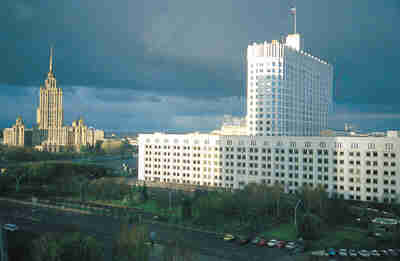![]()
Page 1 of 5
Story
and photos by David Carlson
© Copyright 1995 - All rights reserved
Page 1 | 2 | 3
| 4 | 5
Editor’s note: David Carlson traveled to Russia for the second time in October, 1995. He is director of the Interactive Media Lab at the University of Florida College of Journalism and Communications, and he made the trip to speak at a conference in Moscow entitled "New Media for a New World.” Below are his observations, as an outsider, of the changes in Russia in the past 15 months.
5:30 a.m., Sunday, Oct. 22, 1995
|
| The Russian White House (right) is lit by an October dawn in this view from Carlson’s room in Moscow’s Hotel Mir. Mir is the Russian word for peace. |
Snow is falling.
Across the street, shrouded in fog and blowing snow, is the Russian White House — not the home of the country’s president but the seat of its government, rather like our own Capitol in Washington. Huge, white, floodlit and well-guarded by soldiers even at this ungodly hour, the Russian White House is spectacularly framed by the only window of my tiny room in Moscow’s Hotel Mir.
I can’t sleep. Jet lag.
So, I sit in darkness and gaze out at the Moskva River and the bridge made famous when tanks rolled across it on their way to the White House during the 1991 coup.
Even from the eighth floor it’s obvious things have changed in Russia. The amber glow of the streetlights illuminates a groggy, just awakening city, but it seems Moscow is not just awakening from a night’s slumber. It’s more like a city reborn.
When last I was here in July 1994, Russians lined up for blocks to buy Nikes. Billboards were rare. Everyone was buzzing about those new commercials on Russian TV. Now, there are really bad American infomercials overdubbed in Russian, and the city’s aging, electric buses carry colorful placards pushing Baskin-Robbins ice cream and Budweiser beer.
Capitalism doesn’t have a mere foothold here; it has both feet firmly stamped in concrete like some movie star’s prints on Hollywood Boulevard. Capitalism, in all its beauty and all its ugliness, is everywhere in the new Moscow.
The snow stops, but the day dawns cold and gloomy. From my perch high in the Mir, I can see for blocks. The sides of most streets are lined with kiosks — modular, portable buildings that are the mom-and-pop businesses of Russia. Fifteen months ago, many kiosks were rickety shacks built from whatever materials the shopkeeps could scrounge. Now, stacked shoulder to shoulder with bars on their plate-glass windows, they look like strip shopping centers.
4 p.m. Saturday, Oct. 21, 1995
Naturally, I’m thirsty.
Everybody knows you can’t drink the water in a foreign country. It’s usually not the sanitation; it’s the minerals and stuff, or so says the State Department. It’s one of the pitfalls of international travel. So, even though I never drink water at home, I’m always dying for it abroad. Psychological, I guess.
Bumping along a potholed avenue in a van full of American tourists, I ask our guide to stop at a kiosk to buy bottled water.
Instead, she takes us to a designer grocery store. It’s as big as most American supermarkets but far nicer.
There was nothing like this in 1994. Gourmet delights from around the world fill aisle after aisle, but there’s more: fax machines, cordless phones, Xerox machines, hardware from Europe, Japanese TVs, computers from the U.S., and Swiss tableware. You name it, even those dang Ginsu knives.
The prices are marked in dollars, though customers are encouraged, and in many places required, to pay in rubles. The government wants to keep greenbacks out of the hands of Russians, but it’s a vicious cycle and possibly a battle that can’t be won. The ruble’s value fluctuates so much that some merchants, like the purveyor of these wares, get sick of re-pricing the merchandise. So they mark things in dollars, but as long as the dollar is an alternative currency in Russia, it’s unlikely the ruble will stabilize.
I wander for several minutes amazed at the variety. The place carries virtually everything except meat and produce. Most of the clientele appears to be Russian, but there is not a single Russian product to be found. There is American ice cream, gobs of beer from around the world, but none from Russia. There’s plenty of Vodka, too, but it’s from Finland, Sweden and the U.S. There’s not a bottle of Stolichnaya to be seen.
“Odd,” I mutter. “We think Russians make the world’s best vodka, but they’d rather drink Smirnoff? What’s up with that?
I ask the guide.
"We Russians had Soviet products, only Soviet products, for so long,” she explains, “that we don’t want them any more. We don’t think they’re any good." Then, she shrugs.
It’s not hard to understand why Russians would want Nikes; if you’ve seen Russian shoes, you understand. But it’s ironic that Western ice cream, vodka and beer are popular here. These are things Russians make very well. Their ice cream is famous the world over for its creamy richness. And the beers, especially ones made around St. Petersburg, are a testament to old-world brewing. Everyone knows about the vodka.
It’s another lesson in capitalism. After generations of being deprived of anything made on the wrong side of the Iron Curtain, they’re anxious — no, determined — to sample the world’s wares, even at the expense of their own.
Russian products are out of vogue in the new Russia.
Next page...
